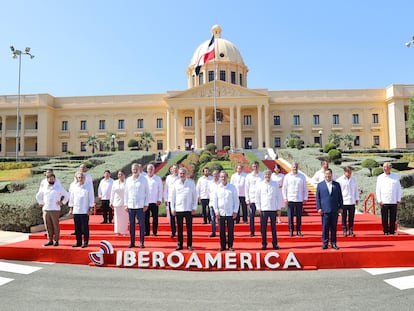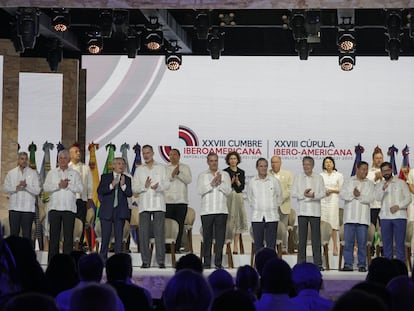US dollar scarcity threatens Bolivia’s ‘economic miracle’
For over a decade, the country was an economic oasis in a turbulent region, with low inflation and high growth. Now a shortage of dollars amid dwindling international reserves is prompting questions about whether it’s coming to an end

Sofia Andrade, a lawyer, chose over the past month to withdraw all her dollar savings from the bank as the US currency became scarce on the streets of Bolivia.
“I prefer to have them at home,” she said. “I fear they won’t let me withdraw them later.”
Like her, many Bolivians are withdrawing their dollar deposits or rushing to buy the US currency amid increased concern about Bolivia’s economic fragility, a marked change for a country that for more than a decade experienced what many called an “economic miracle” amid strong growth, record exports, low inflation, a fixed exchange rate and subsidized gasoline.
The scarcity of the greenback, which opposition politicians attribute to the Central Bank running out of hard currency reserves and the government blames on speculation, means that for the first time since 2011, a parallel market for the U.S. dollar has emerged that charges slightly more than the official price.
When the shortage began earlier this year, hundreds spent the night outside the Central Bank to buy dollars at the official exchange rate. A new system has now been established to buy the currency online. The physical lines have disappeared, but the problem remains and is reminding Bolivians of past economic woes.
Alicia Meneses, 40, said she had converted her savings into dollars earlier this year, “because I was afraid of getting stuck with the bolivianos like what happened to my dad in the ‘80s.”
She needed some local currency this week and so she changed a bit of her savings back to bolivians on the black market in downtown La Paz, where she received 7 bolivianos per dollar, slightly more than the official rate of 6.96.
“I’ve come to change a few dollars because of an emergency,” Meneses said.
Leftist President Luis Arce, who was economy minister from 2006 to 2017 during Bolivia’s period of bonanza, has tried to calm the waters, insisting there will be no change to the country’s managed exchange rate system in which the Central Bank has intervened to keep the local currency’s value stable to the U.S. dollar over the past 12 years.
“There will be no devaluation,” Arce said this week in what was his first interview with a private television station since taking office in late 2020. “There is no need for it when we have a solid economy that is growing.”
The president dismissed speculation he would do away with expensive fuel subsidies that mean Bolivians pay around half of international prices for gasoline — at the cost of draining the country’s international reserves. And Arce painted an optimistic picture: “We’re growing and have the lowest inflation in the region.”
Bolivia’s annual inflation of 2.5% in March marks a decline from late last year when it crossed the 3% mark and is far lower than its neighbors. The government insists Bolivia will grow 4.8% this year, a sharp contrast to the International Monetary Fund’s prediction of 1.8%.
“I’ll disappoint international projections again,” Arce quipped.
Bolivia, an exporter of natural gas for the region, enjoyed a huge economic bonanza over the last decade on the back of high commodity prices, a trend that followed the arrival in power in 2006 of Evo Morales, the country’s first Indigenous president. The landlocked South American country also exports minerals and agricultural products, including soybeans, and has recently seen a surge in gold sales abroad.
Morales used the huge flow of money to reduce poverty, expand the middle class, and build roads. Buildings multiplied in cities, and cars ceased to be a luxury. But that came accompanied with lots of waste and corruption, according to his detractors.
The country’s revenues tripled with the nationalization of hydrocarbon resources in 2006, but the sector stagnated due to a lack of investment, and the country went from being an exporter to an importer of hydrocarbons in 2022, according to the National Statistics Institute.
“They have squandered the money. Now there’s a lack of liquidity,” said Rodrigo Paz, a senator with the center-right Comunidad Ciudadana party. “People are buying dollars due to uncertainty, but those dollars don’t return to the market, they stay under the mattress.”
The commodity price boom ended in 2014, and Bolivia managed to stretch its savings for several years but now, in part due to the COVID-19 pandemic, the country is almost out of reserves.
The government is optimistic it will be able to make up some of the shortfall with the growth in gold mining, but tax revenue from that sector is scant. Of the $3 billion in gold exports last year, public coffers received only $75 million in taxes, according to official data.
“We’re scraping the barrel,” said analyst Gonzalo Chávez, who is an economics professor at Catholic University of Bolivia.
Bolivia can no longer rely on commodities to carry the economy, La Paz-based economic consultant Jaime Dunn said.
“It’s an exhausted economic model that based its success on capturing the surplus generated by natural resources, not on generating wealth. It worked when raw materials fetched high prices,” Dunn said. “The only way to keep it alive is by burning more currency and increasing debt, which already stands at around 70% of GDP.”
Dunn says the government should do more to promote the agricultural sector that has been silently growing its exports. But he says the government is not eager to promote an industry that is concentrated in the eastern region of Santa Cruz, led by an administration that is in opposition to the central government.
Economy Minister Marcelo Montengro has pushed back against criticism, saying the current economic model of subsidies and a fixed exchange rate have contributed to “a robust productive apparatus with price stability and low inflation.”
Social protests, though, are on the rise. Public school teachers, for example, have been taking to the streets for six weeks, demanding more funding. The government has said it can’t meet the demands at a time when it’s facing lots of friendly fire amid public criticisms of Arce’s management by his political mentor, former President Morales, who is also the head of the ruling Movement for Socialism.
“We were coming out of the pandemic that plunged us into crisis, and I feel like we’re sinking again just as the economy was recovering,” said Sofia Godínez, a 54-year-old homemaker.
Sign up for our weekly newsletter to get more English-language news coverage from EL PAÍS USA Edition
Tu suscripción se está usando en otro dispositivo
¿Quieres añadir otro usuario a tu suscripción?
Si continúas leyendo en este dispositivo, no se podrá leer en el otro.
FlechaTu suscripción se está usando en otro dispositivo y solo puedes acceder a EL PAÍS desde un dispositivo a la vez.
Si quieres compartir tu cuenta, cambia tu suscripción a la modalidad Premium, así podrás añadir otro usuario. Cada uno accederá con su propia cuenta de email, lo que os permitirá personalizar vuestra experiencia en EL PAÍS.
¿Tienes una suscripción de empresa? Accede aquí para contratar más cuentas.
En el caso de no saber quién está usando tu cuenta, te recomendamos cambiar tu contraseña aquí.
Si decides continuar compartiendo tu cuenta, este mensaje se mostrará en tu dispositivo y en el de la otra persona que está usando tu cuenta de forma indefinida, afectando a tu experiencia de lectura. Puedes consultar aquí los términos y condiciones de la suscripción digital.
More information
Archived In
Últimas noticias
Aquilino Gonell, former Capitol sergeant: ‘If it hadn’t been for the police, the US would be a dictatorship’
A hybrid building: Soccer pitch, housing, and a shopping mall
Europe urges Trump to respect Greenland following annexation threats
Science seeks keys to human longevity in the genetic mixing of Brazilian supercentenarians
Most viewed
- Alain Aspect, Nobel laureate in physics: ‘Einstein was so smart that he would have had to recognize quantum entanglement’
- Mexico’s missing people crisis casts a shadow over World Cup venue
- Why oil has been at the center of Venezuela-US conflicts for decades
- Trump clarifies who is ultimately in charge in Venezuela: ‘Me’
- Mexico seeks to shore up its defenses following US incursion in Venezuela










































